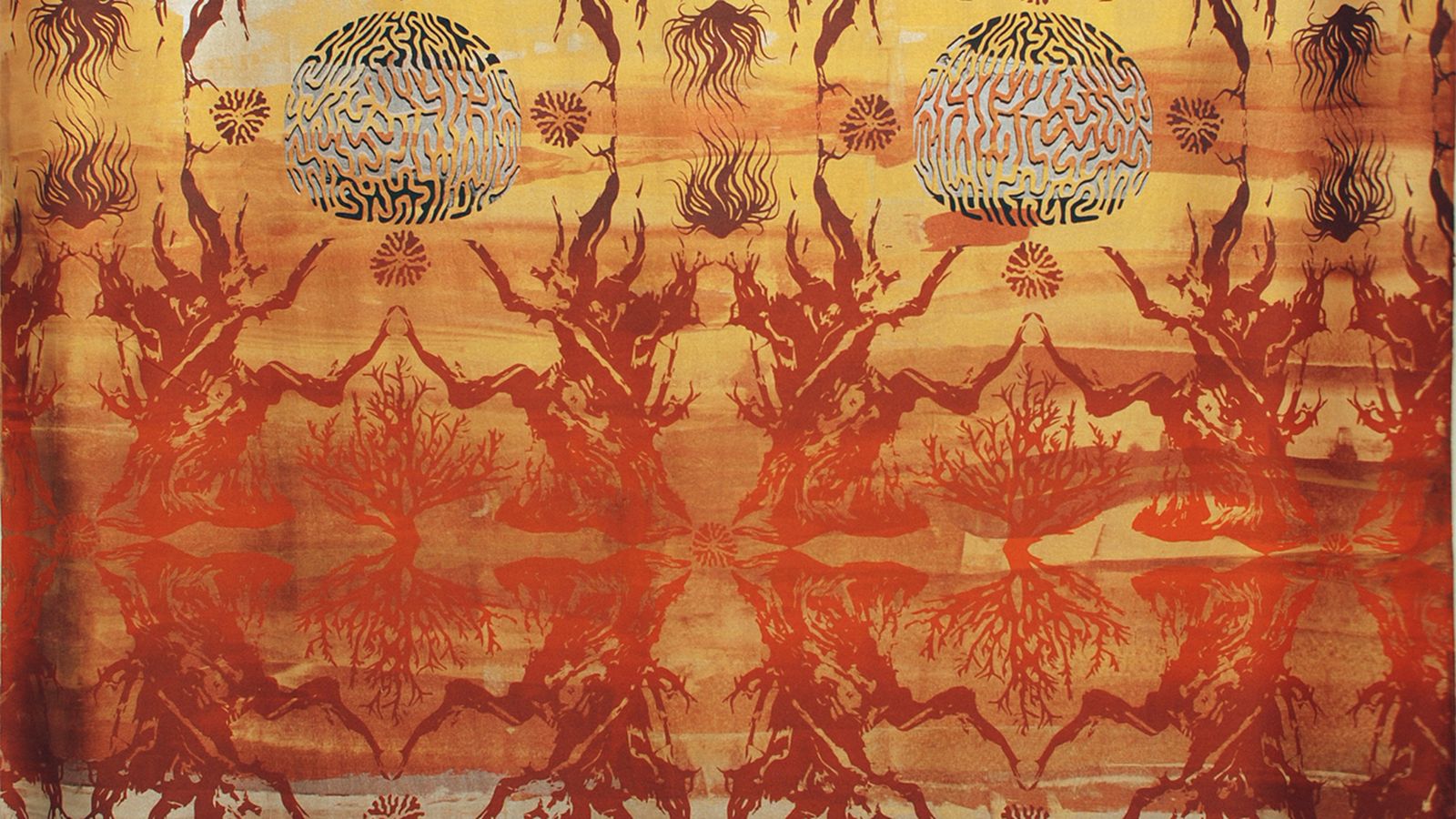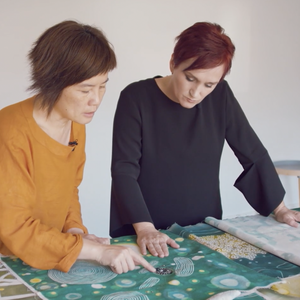Alchemical Worlds: Reflections

Australian Design Centre plays a critical role in celebrating the work of Australian artists who embrace the highest degree of skill and who continually explore material, process and ideas to advance contemporary craft and design practice.
Object Space is our window gallery located at the Australian Design Centre HQ on William Street, Darlinghurst, on view 24 hours a day.
24 November 2022 - 28 January 2023
Alchemical Worlds: Reflections connects undeciphered ancient alchemical mirroring and symmetry compositions with climate science research on coral and trees. The repeat pattern on Ahimsa or peace silk features the Great Basin bristlecone pine (Pinus longaeva) and brain coral (Diploria labyrinthiformis) – the oldest known living species on earth, close to 5,000 years. These ‘bioarchivists’ are significant non-human living entities that hold long-term climate data beyond human records.
The printed textile length provides a backdrop for animated sculptural form made from found wood and intricate crochet that re-imagines an active community of ‘bioarchivists’. The artists explore a magical world of climate stories by combining these materials, images and objects.
Agnieszka Golda and Jo Law are collaborators based in Wollongong, on Dharawal Country. Agnieszka’s practice focuses on textiles, sculptural installations, and painting. Jo specialises in media arts, animation and film. They work with researchers in environmental sciences, materials science and engineering to combine traditional techniques and novel technologies in artworks that respond to socio-cultural issues of climate change and well-being. Their works have been exhibited at the Museum of Applied Arts and Sciences, Sydney and internationally in Hong Kong, and Japan. The Alchemical Worlds series is assisted by the Australian Government through the Australia Council, its arts funding and advisory body.
Alchemical Worlds: Reflections, 2021
Screen printed Ahimsa silk, $2,500
Alchemical Worlds: Reflections, 2022
bamboo, found wood, cotton and electronics
Animated Sculpture, $3,500
Q & A with Agnieszka Golda and Jo Law
How does your collaboration with each other influence your work?
Our collaborations have deepened our interest and investigations into the idea of ‘animation’. How can we animate the inanimate and reveal or evoke life in materials and objects to create familiar yet strange scenarios that reflect the world around us. In Alchemical Worlds: Reflections, we constructed an animated scene that references corals. These fascinating animals form some of the most diverse ecosystems in the world.
In your work you focus on issues such as climate change and well-being. Why is this a focus?
Climate change and well-being of humans and non-humans are interrelated. Current climate and environmental crises can, directly and indirectly, impact physical and mental health. Psychological challenges associated with climate change reveal a phenomenon called 'eco-anxiety' or 'ecological grief. In addition, the continuous spread of the COVID-19 virus has had an enormous and diverse impact on people globally. Through our collaborative projects, we employ 'eco mindful’ making and thinking. We consciously position our projects at the interaction of art, craft, science, and technology to offer creative, relational responses to dual global crises facing us today: climate change and well-being.
Tell us about your project ‘Materials science, slow textiles & ecological futures’. What was the outcome of this project?
This project builds on our 2017 Visiting Research Fellowship at the Museum of Applied Arts & Sciences (MAAS), which investigated using traditional slow textile techniques used in the Museum’s Asian collection to embed conductive materials into fabric. We invited materials scientist Dr Sepidar Sayyar and climate scientist Professor Helen McGregor to collaborate to incorporate innovative materials such as conductive graphene, and current climate data into large-scale e-textile artworks.
Spinning World (2018-19) exhibited at Sydney’s Powerhouse Museum was the creative outcome of the project and depicted stories of our changing climate to inspire meaningful action through multisensory and participatory installation. We continued our collaboration to produce Alchemical Worlds (2021) exhibited at Wollongong Art Gallery and a new adaptation of this exhibition will be presented at the Creative Media Centre, City University of Hong Kong in January 2023.
How do you incorporate ‘slow textiles’ processes into your work?
Our e-textile works use 'slow' - labour-intensive, repetitive, and hand-made processes. A slow approach to making focuses and, as a result, calms the mind. It encourages mindfulness and environmental sustainability and enables expressions of care and connectivity with our communities and the natural environment. The images are hand-stencilled and screen-printed by hand, threads are crocheted, fabrics are hand-stitched and sewn, and even the electronics components like speakers and electromagnets are hand-made using methods like embroidery.
Your printed textile work in Object Space, Alchemical Worlds: Reflections, connects ancient alchemical patterns and climate science. What was involved in making this work?
In this repeat-pattern textile artwork, the Great Basin bristlecone pine (Pinus longaeva) and brain coral (Diploria labyrinthiformis) are transformed through slow-making methods and sustainable approaches. Alchemists' attempts to transmute mundane substances into precious metals led to the discovery of many pigments, paints, dyes, and art materials. The work draws on compositions of mirroring and symmetry based on undeciphered images from ancient alchemical journals. The background is hand-painted with upcycled metallic inks in copper, gold and silver. The surface is then overprinted with marbled opaque inks depicting the recurring motifs. The Great Basin bristlecone pine and brain coral are brought together and transformed into a repeat pattern printed on Ahimsa (peace) silk. This artwork harnesses the interaction between the opaque and the shimmering qualities of metallic gold and glitter paint to hint at the communal structures of these bio-archivists who maintain ancient climate records that span thousands of years. Together these species provide essential data that helps us understand our changing climate.
Image top: Agnieszka Golda and Jo Law, Alchemical Worlds: Reflections (detail) , 2022 Photo: Courtesy of the artists
Video: Agnieszka Golda and Jo Law, Alchemical Worlds, Wollongong Art Gallery 2021. Video: Courtesy of of the artists


/https://adc-2-prod.s3.amazonaws.com/media/dd/images/Australian-Design-Centre_Amy-Piddington-136-Web.30ddf99.jpg)
/https://adc-2-prod.s3.amazonaws.com/media/dd/images/Australian-Design-Centre_Amy-Piddington-069-Web.f315687.jpg)